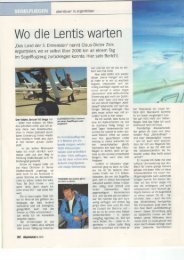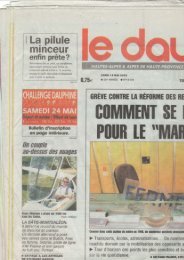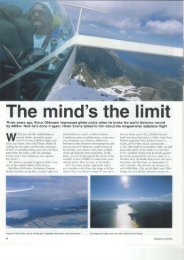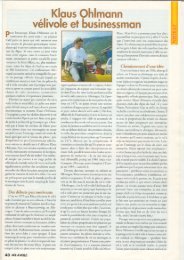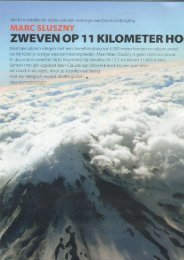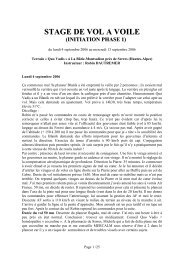Create successful ePaper yourself
Turn your PDF publications into a flip-book with our unique Google optimized e-Paper software.
ll<br />
I
WINNING ON THE WAVE<br />
I<br />
IKE PUTTING a man on the moon,<br />
I<br />
climbing to the top of Everest or<br />
tstrudging to the South Pole the Kûttner<br />
Prize was a race - a contest of endurance<br />
and skill in an extreme and unexplored<br />
environment. The goal? To fly 2,000km<br />
- 1,243 miles - in one direction, replacing<br />
the power of combustion with the power<br />
of nature. lt was a prize rooted in the very<br />
beginnings of gliding - and a dream thar<br />
was only realised within the last year.<br />
When soaring was in its infancy, pilots<br />
believed that wind on the lee of hills and<br />
mountains hugged the ground, producing<br />
downdrafts. Hans Deutschmann and<br />
Wolf Hirth, two Cerman glider pilots,<br />
serendipitously discovered a powerful type<br />
of lift while soaring over a small hill in<br />
Silisea, Cermany, in 1933. In the flimsy<br />
wooden and canvas glider Deutschmann<br />
and Hirth were thrust skyward gaining a lot<br />
of altitude rapidly.<br />
Joachim Kûttner, a young scientist and<br />
talented glider pilot, was the first to study<br />
scientifically this phenomenon on the lee<br />
side of mountains. During a gathering of<br />
soaring enthusiasts in a small competition<br />
he convinced the pilots to carry instruments<br />
to record their flights. When he analysed the<br />
data, Kûttner confirmed his suspicions that<br />
wind flowing over mountains generates<br />
waves very similar to standing waves or<br />
rapids in a river. These days, every glider<br />
pilot knows that - like a river flowing over<br />
boulders - wind encountering mountains<br />
forms a series of standing waves downwind,<br />
and on the front edge of each you can find<br />
very smooth, powerful lift. But it was Kûttner<br />
who coined the phrase "mountain waves".<br />
He spent his early career exploring them.<br />
When a wave is really pumping, its<br />
power is palpable. The sound frequency of<br />
mountain waves is too low to hear but the<br />
pressure fluctuations generated can be felt<br />
through your body as a deep resonating<br />
hum. The sub-audible vibration can build<br />
tension like a bow being drawn across the<br />
bass note of a cello. ln 1937, Kùttner stood<br />
below such a wave in Riesengebirge,<br />
Cermany. Dwarfed beneath the huge cigarand<br />
saucer-shaped clouds, ignited by visceral<br />
excitement, apprehension and desire to<br />
explore how high the wave reached, Kûttner<br />
took his fragile low-performance wooden<br />
glider into the jaws of his first giant wave.<br />
Flying in front of the cloud in an open<br />
cockpit he soon caught the ascending air.<br />
The altimeter was adequate for most aircraft<br />
of the day: few ever flew higher than its<br />
maximum of 10,000ft (3,048m). Soon it<br />
became useless as he wound it off the dial.<br />
Most pilots begin breathing supplemental<br />
oxygen at 10,000f1 but back in 1937 the<br />
body's oxygen requirements at high altitude<br />
were poorly understood and Kûttner flew<br />
without the luxury of oxygen.<br />
At 12,000ft (3,658m) the air temperature<br />
dropped well below freezing but Kûttner<br />
remained in lift and continued climbing.<br />
At 20,000f1 (6,096m) his extremities started<br />
to lose circulation and began feel very cold,<br />
36<br />
Opening picture, overleaf: Soaring wave 30,000ft above<br />
New Zealand. Photos like this, taken by Marty Taylor<br />
with the help of Gavin Wills, will be used in a highguatity<br />
calendar available from www.exiremegliding.com<br />
and oxygen deprivation would have started<br />
to affect his judgment. lmpelled by the<br />
explorer's desire to go where no one had<br />
been before and bv the scientist's curiositv.<br />
Kùttner was able tô over-ride his extreme<br />
discomfort, but he was unaware of the real<br />
danger stalking him. With less oxygen his<br />
judgment became blunted by euphoria.<br />
At 23,000fr (7,010m) and enduring -35'C<br />
Kûttner realised that he could no longer feel<br />
his frostbitten feet and that his fingers had<br />
turned blue. Such extreme cold would have<br />
forced many pilots to abandon the flight but<br />
the decision to retreat only came when<br />
Kûttner realised he was seeing two suns. The<br />
creep of cognitive impairment due to oxygen<br />
deficit is insidious and a pilot can often fly<br />
without noticing the signs that something<br />
is not quite right. Seeing two suns was a<br />
clear-cut sign that something was severely<br />
wrong. At this point Kùttner turned away<br />
from the lift and rapidly descended landing<br />
in a small Polish village a long way from his<br />
start point. His physical ailments soon<br />
healed but he never recovered from his<br />
desire to understand and explore the power<br />
and beauty of the mountain wave.<br />
Sierra Wave Project<br />
Two years after this flight World War Two<br />
intervened, putting Kûttner's plans to studv<br />
and explore wave on hold while he flew as<br />
a test pilot for the Cerman aircraft industrr,.<br />
After recovering from the horrors of the w,ar,<br />
Kûttner joined the Sierra Wave Project - a<br />
meteorological programme run by the<br />
US Air Force to investigate mountain wave.<br />
The Sierra Nevada is an old mountain<br />
range that has been battered and eroded<br />
by winds ploughing into it. After countless<br />
millions of years the ranges are shaped more<br />
like the top half an aerofoil than the jagged,<br />
mitred peaks of young mountains. The<br />
smooth shape and gentle curve of the Sierra<br />
Nevadas commonly trigger a spectacular<br />
lee wave. Once in the wave a pilot can<br />
expect serenely silk-smooth lift without even<br />
the slightest hint of turbulence. However,<br />
wave harbours an unpleasant, less benign,<br />
bedfellow: rotor. On April25,1955, Kûttner<br />
and his colleague Larry Edgar were on a<br />
routine investigative flight when they<br />
encountered the full furv of a demon rotor.<br />
After several hours' flying between 30,000ft<br />
and 40,000ft (9,144-12,192m) the pair<br />
descended: Kùttner first, then Edgar. At<br />
17,OOOft (5,'181m) Kùttner was ripped into<br />
by horizontal sheets of wind that catapulted<br />
him within seconds of his glider's maximum<br />
speed. Fast approachingVNe, Kûttner pulled<br />
up and climbed vertically. He still had too<br />
much speed. The next option was a highspeed<br />
stall. After dropping nearly 1,000ft he<br />
recovered only to be hit by another gust. He<br />
must warn Edgar. lt was too late. The same<br />
belt of destructive turbulence had consumed<br />
Edgar. Porrerrul rotor clouds were forming<br />
all around hinr. L'nsighted by the rapidly<br />
forming cloud he could not execute the<br />
same escape Kùttner had performed without<br />
losing contr()l of his plane. The terrific power<br />
of the rotor brut..rllr flung Edgar pastVNr<br />
with a force of I lC and rvrenched the wings<br />
off his glider - hurling him out of the plane.<br />
Edgar's parachute opened itself while his feet<br />
were caught in the cockpit. The shear forces<br />
were enough to have torn him in two.<br />
Luckily, the onlv casualties were his boots,<br />
helmet and gloves. The enormous C-forces<br />
blinded him and the hose from his bailout<br />
oxygen bottle was destroyed.<br />
Out of the plane, his ordeal was not over:<br />
instead of drifting gently toward the ground<br />
under the resistance of his parachute, he was<br />
grabbed by the rotor, which vaulted him<br />
higher. Miraculously, Edgar survived the<br />
landing without breaking a bone.<br />
Despite the potential dangers, the tug of<br />
Sailplane & Gliding
h<br />
lce Papziân (above) tbw wM top fil,rt Jean_Lraie chtu"<br />
enture, exploration, saientific disaou..*<br />
in Aryenti^ AS wer as with Many' whoo- thank go to Jean'tnaùe crenen ror hisâsrp ûvww€nremgfiding.com)<br />
;i:lôîniïil:î:îjfi;.",,H:Iï3, Ëi[:iîSïîilj#;lîi1"il'j"iJ3,^,,. ,, rieslosse{seven<br />
!::.iËd'-irr+i,rdfitï :{ttrri:#:J^,ïilTx*imËi""l,rr'<br />
:ïiiù'i','*ffi#Ti:f,':if:i<br />
,:,ri,îË**T:Ë:[fl:11:ffi;,<br />
fril.Ltfl"'ffi#;jj,'",:i,Ï,frïfu,<br />
fl#ii,fdîi],iii,hï,<br />
+;;liltfia;iliffi ni'i#îiriîftlaï:ififfi ,* $i*nîql*#1d<br />
plrut*:tmm xgffin{ffi lgl***ffi,<br />
î*ffi f*i'$#* r d,l;.ihï['i"l]ïid:i,:i'*,," ", l,fi;ri* llril+,r:,,;:iïffi .,_<br />
37
WINNING ON THE WAVE<br />
- known locally as the Nor'west Arch -<br />
oscillates across South lsland in the lee of<br />
the Southern Alps. When conditions are<br />
ideal it can run almost the entire length of<br />
the South lsland and stretch across to the<br />
eastern tip of North lsland.<br />
Inspired by Kûttner's flight, Ceorgeson<br />
believed that he too could make long<br />
distance flights in "his wave". Unlike<br />
Kûttner, he would have to go crosswind,<br />
not downwind, to fly significant distances.<br />
On February B, 1953 he flew 90 miles<br />
(144km): the first crosswind wave flight in<br />
New Zealand. Six weeks later conditions<br />
again looked ideal for a long distance flight.<br />
Local authorities - unaccustomed to dealing<br />
with gliders - requested a flight plan that<br />
included details about the engine type,<br />
route and estimated time of arrival. Slightly<br />
embarrassed, Ceorgeson conceded he was<br />
unable to fill out the plan accurately. After<br />
fudging it by presenting an ideal scenario,<br />
he took off , 204 miles (32Skm) from his<br />
declared destination. As an amateur he had<br />
the barest of resources and had never used<br />
oxygen. At 14,000ft (4,267m) he pulled his<br />
oxygen mask on but the clip holding the<br />
mask in place broke. For the rest of the flight<br />
he was forced to hold the mask to his face,<br />
unsure whether he was keeping the dangers<br />
of hypoxia at bay. He climbed rvell to<br />
22,OOOft(6,705m) and headed south across<br />
the leading edge of the wave. During the<br />
flight there were several heart-stoppinfl<br />
bangs that made Ceorgeson wonder if his<br />
plane was disintegrating due to the extreme<br />
conditions. lt was not until he had landed at<br />
his destination - within one minute of his<br />
ETA - that these were explained. When he<br />
opened the cockpit the Perspex fell out.<br />
The metal frame and Perspex canopy had<br />
different contraction rates and the low<br />
temperatures had cracked the Perspex. His<br />
was the first major crosswind wave flight.<br />
These flights were the precursors of all<br />
modern wave flying and the rationale behind<br />
Kûttner's challenge to pilots to be the first<br />
to flv 2,000km: "l am sure I would have<br />
tried the 2,000km long ago," he says, "but<br />
I pursued other exciting projects." He was<br />
appointed to a leading position in the<br />
Mercury Project that aimed to put the first<br />
38<br />
Left: Klaus Ohlmann, because they doubled back on themselves,<br />
photographed here by landing where they had launched.<br />
Mafi Taylor, spotted the According to Klaus Ohlmann, another<br />
potential of the Andes, brilliant wave pilot, these flights stunned the<br />
explored them with the gliding world: "People in Europe could not<br />
OSTIV Mountain Wave believe this. We had been trying for many<br />
Project, and shared his years and we were only flying a little over<br />
weather obseruations. lt half this distance. This type of out-and-return<br />
meant he was up against flight was unprecedented and a little<br />
strong contenders for the unconventional. But the flight was so<br />
prize, such as Steve outstanding it caused the FAI to devise a<br />
Fossetf and Terry Delore, new class to honour it. Pilots everywhere<br />
and Jean-Marie Clement began studying the Lynskey and Delore<br />
flights to understand how they had achieved<br />
this distance. We found the answer lay in<br />
wave - just as Kûttner had predicted."<br />
After learning of the New Zealanders'<br />
-J fiuww.extremegliding.com/ flights, Ohlmann opened an atlas to look<br />
for places with very similar conditions to<br />
astronauts into orbit and played a significant New Zealand: mountains that ran north<br />
leadership role in the race to put the first to south for more than 2,000km with<br />
man on the moon. After his work at NASA consistently strong winds blowing from the<br />
he was appointed head of global field<br />
west. The Patagonian Andes looked like the<br />
projects by the World Meteorological<br />
most likely place. Polar and tropical jet<br />
Organization. By 1987, when he realised streams blow above normal weather systems<br />
nobody had taken up the challenge, he put at altitudes greater than 20,000ft (6,096m)<br />
the prize forward as an incentive to pilots and can reach speeds in excess of 400km/h.<br />
around the world to investigate the extremes He was convinced these factors would help<br />
of flying in wave. According to KÛttner: him set new distance records.<br />
"l issued the challenge because I believed Flying in Patagonia is exhilarating but<br />
2,000km could be flown, but only in wave." risky. There are vast tracts of country for<br />
In European gliding circles, where longdistance<br />
flights typically relied on thermals conditions collapse. Since 1997 Ohlmann<br />
hundreds of kilometres without an airstrip if<br />
and were limited to the hours of daylight, explored the power and idiosyncrasies of<br />
people began to claim that the KÛttner flight the Patagonian wave systems.<br />
was impossible and that Kûttner knew it<br />
ln the 2OO2-3 southern hemisphere flying<br />
could never be achieved. This myth was season his years of exploration paid off<br />
perpetuated by pilots who pointed to an when he broke Crosse's 3O-year free distance<br />
extraordinary free distance flight made by record, becoming the first person to fly more<br />
Cerman gliding ace Hans Werner Crosse in than 1,500km in one direction. He also<br />
1972 over 1,460km from Lubeck in<br />
completed an extraordinary zig-zag flight,<br />
Cermany to Biarritz in France. This record becoming the first man to fly 3,000km<br />
stood for 30 years. He used every available (1,865 miles) in a sailplane.<br />
minute in the day and squeezed every scrap Despite these dramatic flights, Ohlmann<br />
of speed out of his high-performance glider was most excited by an observation he<br />
and the flight was still more than 500km made. He was convinced that during<br />
short. Others presented scientific data<br />
November and December the polar and<br />
showing that the flight would be impossible tropical jet streams worked together to<br />
because weather systems are significantly create a highrvav in the skv that exceeded<br />
shorter than 2,000km.<br />
the 2,000km Kûttner distance. Instead of<br />
keeping this a secret, Ohlmann contacted<br />
Inspiration<br />
Ki.ittner, who consulted relevant scientific<br />
An'av from Europe, Ceorgeson continued to weather data, which confirmed the<br />
nr.rke extraordinarv flights in New Zealand, observation.<br />
collecting rvorld records for<br />
ln the 2OO3-4 summer season - the UK's<br />
dist.rnce .rnd height gain w'hile surfing the<br />
Nor'\\'est ,{rch. In the sunrnrer of .l9l-l last winter - three serious contenders<br />
descended on the Andes keen to claim the<br />
Ceorgeson set .t netr clt'c l.tre'cl , clist.tnc'e Krlttner Prize Ohlmann. the undisputed<br />
record of 1,25-lknt in one direction lrut r hanrpion of long distance; Delore and<br />
people who analvsed th.rt soon re.tlise'cl his co-pilot and sponsor US billionaire<br />
setting a free distance record in \err<br />
balloonist Steve Fossett (who in Kuttner's<br />
Zealand would be impossible bec.-ruse the vien' posed the greatesthreat to Ohlmann);<br />
country is too short.<br />
and a small but very talented French team<br />
Ceorgeson became the inspiration for a led by multiple record holder and aesthete<br />
new generation of New Zealand pilots. Jean-Marie Clement - who was inspired<br />
On December 14,1990 Ray Lynskey bv the "beauty of the flight".<br />
became the first glider pilot to fly 2,000km On November 14, Delore and Fossett<br />
and in 1994Terry Delore became the<br />
claimed first blood with three records for<br />
second, extending Lynskey's record by<br />
speed and out-and-return distance.<br />
23km. Despite flying the distance required Ohlmann was in the air at the same time but<br />
neither flight met the Kûttner criteria<br />
made a tactical error in his choice of task.<br />
Sailplane & Gliding
Klaus Ohtmann,s own<br />
photo of Andean wave,<br />
taken near Bariloche.<br />
Klaus holds FAI records<br />
for:the lS_Metre Ctass<br />
free distance, using up to<br />
3 Tps (2,029.7km, on<br />
01/01/02);with Herué<br />
Lefranc, the Open Class<br />
free distance (2, | 74.Skn,<br />
on 23/1 I /05); Open Ctass<br />
free distance, using up to<br />
3 Tps (5,009km, on<br />
21/01/05);Open Ctass<br />
free O/R distance<br />
(2,247.6km, on 02/t 2/03);<br />
Open Class O/R distance<br />
(2,245.6km, on 02/t 2/0J)<br />
Of the other contenders.<br />
Steve Fossett hotds two<br />
Open Class gtiding<br />
records with Terry Delore,<br />
and 33 other FAI records.<br />
Terry Detore hotds two<br />
current and l2<br />
previous gliding records<br />
Abgye af l, this mistake acted as a reminder<br />
to Ohlmann that<br />
and<br />
he<br />
his<br />
was<br />
co-pirot<br />
in competition<br />
Herve Lefranc<br />
some with<br />
of France. panicked. ,,Report<br />
of the best wave to<br />
pilots 2,000ft<br />
i" ,[u A<br />
*orfa.<br />
week later the weathbr pra,"r", pï!?t'#lÎ,.,Î:;,:l'l,îflf"::fflj''n,<br />
,Ëpeared<br />
l: bu setting up<br />
have<br />
i fif":,^oî:o the voice over<br />
wel<br />
taken'h;'<br />
the<br />
tor more records.<br />
signiricanir/<br />
Each<br />
r;'îii,"iJi.n<br />
ha! one with<br />
leam<br />
eye on the<br />
the record.'nËu'tnuii li:^i6il,ï:1';ï:<br />
wearh;;;;d<br />
eye o,l<br />
one<br />
[,"iit, :î3:',ï1,il*iffi1<br />
the competition prize<br />
white j;;i;;ly<br />
in their sigh.ts and the :r^î*;;' iToo,jéant.voice,; ,uy, orrrmann, ,,f asked<br />
guarding their<br />
threat<br />
task selection<br />
of another<br />
and "Ët-btu'"nt this'charminË<br />
team<br />
intentions.<br />
,on November<br />
waiting in'calafate<br />
Ë#{iprease, .r am frying<br />
the<br />
a<br />
19, pair<br />
ct".uni decided,to<br />
*àrra recordl can I fiy arong<br />
,*"Ë"ir"a<br />
the<br />
a buifding<br />
r,"d--;;9 ;p;;fl^1r;i west of the<br />
wave<br />
preparing<br />
sysrem and<br />
and relax-ing'<br />
.i!, ;';sîùï,;r,nte?,,<br />
out-and-return ôfr"""i'""<br />
To their relief<br />
with his heart<br />
to<br />
were<br />
extend<br />
arone<br />
they<br />
tfr"'iu.oràJ<br />
in carafatà<br />
in his mouù ohrmann waited.<br />
previous<br />
r"t tf,u<br />
bureaucracy<br />
wourd<br />
week by Delore<br />
undo this<br />
iàrrËtt. ,,beautifur,,fright?<br />
Detore<br />
"nO<br />
fnu<br />
team had been<br />
A four-year<br />
doffi'ËiîË.troni.<br />
wait<br />
After what felt like an<br />
and operational<br />
rhe sun<br />
hasslesiàëe<br />
'.i*!'nàr,.ry<br />
coitecting<br />
one<br />
tf,e<br />
hour earri -, ggain firecl i"ià<br />
of the<br />
carafate<br />
[::11.-:rds<br />
season<br />
tr'"n<br />
and<br />
in<br />
decided<br />
tr,é no,ir',ï;#<br />
onger-term<br />
the<br />
weather<br />
and<br />
.l!Jï,<br />
prospects<br />
Derore were<br />
iJf,iî:'jlrî;1li,i*iil*irïî"r'':<br />
looked<br />
based'<br />
more<br />
râ oÈrr*n<br />
:nc9:tr1gjng. Delore<br />
Lefranc<br />
and<br />
put<br />
were<br />
his efforts<br />
firsr.in<br />
irrri,,<br />
amiliarising<br />
intr_r<br />
the<br />
between<br />
;;'Noîuru",.<br />
Meidoza and san<br />
himself<br />
23,<br />
Juan<br />
*itn "i; ;;.ËËa"a ,;ôd,il ,ôî,,ô)on.with 2003.<br />
to.ut<br />
Both pirots<br />
.""jiiir",<br />
*uiu in rrigi airbrakes<br />
out the<br />
after<br />
spirits<br />
llrl:":':.q<br />
probtems<br />
their succeisful<br />
À" *ul'nuuing<br />
rrigÀt<br />
ô;;'. keep<br />
letorg putting<br />
t;t;'*^1";;n",.<br />
below ài,o'oo^(l 9,6B6ft) the<br />
the<br />
reports<br />
call out<br />
that<br />
to forruti<br />
confirmedihe<br />
;#'h"* arong tr,u ,trnÀing<br />
lem in<br />
to'rejoin<br />
let strËairs<br />
cordi,era with<br />
Calafate.<br />
falling into<br />
were<br />
alignmen-t'<br />
trpr"qlr"<br />
"f r'ia<br />
unjA.on..!ua<br />
oà"n towering above<br />
Having flown in patagonia<br />
ror<br />
*aiting<br />
these conditions.for<br />
them:<br />
for<br />
)ur<br />
the previous<br />
four ;l know<br />
years,,,<br />
tn"* and<br />
seasons,<br />
"rfiàys<br />
mountains<br />
Ohlmann<br />
ohlmann.<br />
recallËd<br />
had experi"ni*<br />
"rhe<br />
iràï,nr"i"g<br />
beginni's;itËi'sll;à;<br />
.lirbld ,h",,op of the highest<br />
nd local,knowledge<br />
tremendous<br />
on his,ij".<br />
as<br />
r]"i-n"*<br />
muàh for tie rrnàifàpu.",<br />
ilJ"il<br />
"r,n""c'iiiÈîr.,Jl* y"u.,go,,,<br />
very peak and<br />
for<br />
evùy<br />
the<br />
wave<br />
weather<br />
,r^ o^l1rann. ,,they<br />
system<br />
conditjons _<br />
alafate<br />
from<br />
inËîà"Lrirrr<br />
ur" uury impressive<br />
in the south to San jilun<br />
glacierslipping<br />
in<br />
into<br />
Ëï,",ùru<br />
rrth.<br />
iÀu<br />
the<br />
is<br />
Àrr"'i.Ër.<br />
nowhere to land. My mao<br />
He knew that<br />
wave<br />
rn"<br />
predicti"finË'*àrtnur<br />
was wef l marked<br />
;fd;<br />
and<br />
an<br />
the<br />
airfield<br />
southwest<br />
bril corld not see it.<br />
as.a. cross between<br />
wind<br />
an<br />
pushed<br />
art, a science<br />
us stronglv'"<br />
we continued<br />
rmbfe.<br />
and<br />
On<br />
a<br />
witÀ iïr'"urs.<br />
north, arong endress renticur.rr<br />
November<br />
make the<br />
19<br />
flieht<br />
to<br />
h; ,h*ù;<br />
the<br />
crouds.<br />
tactic<br />
w the jet<br />
;;<br />
was ro 1F9lt9!Èi iii*orra be possibre<br />
with ry r1-; to<br />
streamstarto synchronise<br />
re,up.<br />
and<br />
With such talented Iitot, on "f,"i,<br />
an air slpeed<br />
;Ëi:,<br />
or lzoeÀ)Ë';il'Jsr":<br />
reast 2,40dkm bu*he 6,000m rimit<br />
rhem prenry of time.t<br />
pievented<br />
o ,, f;;ô;;;î; the<br />
decldgd<br />
,uif<br />
.fty<br />
the 2,i quiet raminar<br />
to throw<br />
san<br />
z"o"kr ,o<br />
caution to the<br />
t to<br />
wind<br />
Cafafate<br />
and<br />
as soon as he.oriJ ""'"<br />
Juan' The taif<br />
iro*<br />
wind<br />
at least.<br />
ÉeaÀ,.Ârij')okrur,<br />
1,000m trizaltt) abo'e<br />
;;;ffi<br />
us.<br />
we ftew in the b;;py rurbutence<br />
In a,flamboyant<br />
:l!!ffiiJ,iïA;-ffiïX:*m:a''puua .i,r,"î","r systems.<br />
move rr" prrnîJà<br />
As we passecr<br />
:end<br />
to<br />
the free distance<br />
rhe pair<br />
s.,n<br />
record<br />
nith"i,<br />
ruan<br />
he<br />
rvious<br />
set<br />
maximum,p;;l<br />
the<br />
year by flving.from<br />
Lago Fonrana<br />
Mrj;r;;';;<br />
where î,"g il:#ff:1i?t.[îîâ,ff<br />
they reach;J r,:,1,r";,;.;"<br />
lafate.- a disianée<br />
and<br />
ôb-krÀ<br />
Lf<br />
most<br />
l,ozzk^_-und-net<br />
of the ftight wâs ft;;;l;il"""<br />
ËËffn"']" the north of Arsentin.r. Th.<br />
r position for the<br />
4,000<br />
2,000km<br />
and 7,000.-113,<br />
z,ôookm<br />
Krittner'fjiËf,t.<br />
125<br />
Kûttner<br />
22.,g;;ft;". ftighr \;; mine.., He .rnct<br />
This was a difficult<br />
Tension<br />
flight,,;;;;;iili"'t<br />
lann. ,,From<br />
durins<br />
Lefranc<br />
the early<br />
landed<br />
,,a"i<br />
at epm, i1lr, l5 minures<br />
flisht<br />
;iii<br />
rsquel,ïÉ"i"<br />
had in"<br />
eentt;met,J<br />
and<br />
.j"ra<br />
"<br />
2,12okmarier iheir rake_.rr.<br />
very<br />
joined<br />
dense, t"tendozâ ";;;i;iiïtÀu<br />
pui,.<br />
,"1_y,a1 we had to ftv<br />
airspace.<br />
s, i; Feb,.uai1,loil,<br />
:<br />
fuith",<br />
rÉ" *ii" àrïn"<br />
.;;,. rr.riring<br />
ano<br />
,o<br />
nearrr<br />
rrsk flyins away i".*, rhe 9_t_iear_,rlJ<br />
from the good t;j'ill.f,"#,:ïljlt-f3:y;; iËadio, xrttner<br />
ditions."<br />
;;";;;;<br />
hancled<br />
Oespïe<br />
prize roohrn,.rnn<br />
these troubles<br />
*ho<br />
Ohlmann<br />
h.rcr<br />
ber - November ZO04<br />
radio<br />
iiË.:'Âii'iL"ji'Il,tffi.'iX'"<br />
"Uh' nesative," replieâ o-hi'.nn, stightty il":l'.::iijil lî;ffi'lil;;.:;:,ijlÈù' \<br />
:<br />
jII<br />
I



